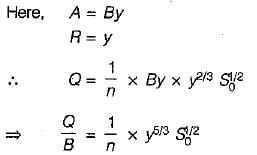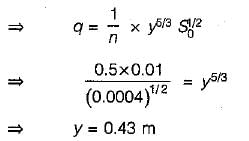Civil Engineering (CE) Exam > Civil Engineering (CE) Questions > What is the normal depth in a wide rectangula...
Start Learning for Free
What is the normal depth in a wide rectangular channel carrying 0.5 m2/s discharge at a bed slope of 0.0004 and Manning’s n = 0.01?
- a)0.13 m
- b)0.32 m
- c)0.43 m
- d)0.50 m
Correct answer is option 'C'. Can you explain this answer?
Verified Answer
What is the normal depth in a wide rectangular channel carrying 0.5 m2...
For a wide rectangular channel, the hydraulic radius (F) is approximately equal to the depth of flow. By Manning’s equation, we have,






Most Upvoted Answer
What is the normal depth in a wide rectangular channel carrying 0.5 m2...
's roughness coefficient of 0.025?
Using the Manning's formula:
Q = (1/n) * A * R^(2/3) * S^(1/2)
where:
Q = discharge = 0.5 m2/s
n = Manning's roughness coefficient = 0.025
A = cross-sectional area of the channel
R = hydraulic radius = A/P, where P is wetted perimeter
S = bed slope = 0.0004
We can rearrange the formula to solve for A:
A = Q * n * (P/R)^(2/3) * S^(-1/2)
To find the normal depth, we can assume that the cross-sectional area is a rectangle with width (b) and depth (y), so:
A = b * y
The wetted perimeter can be approximated as:
P = b + 2y
The hydraulic radius is then:
R = A/P = y * b / (b + 2y)
Substituting these expressions into the Manning's formula, we get:
Q = (1/n) * b * y * (y * b / (b + 2y))^(2/3) * S^(1/2)
Solving for y, we get:
y = (Q / (1/n * b * (b + 2y)^(2/3) * S^(1/2)))^(3/5)
This equation can be solved iteratively using a numerical method, such as the Newton-Raphson method. Alternatively, we can use trial and error to find a value of y that satisfies the equation.
Assuming a channel width of 5 m, we can try different values of y until we get a discharge close to 0.5 m2/s:
For y = 0.5 m:
Q = (1/0.025) * 5 * 0.5 * (0.5 * 5 / (5 + 2*0.5))^(2/3) * 0.0004^(1/2) = 0.165 m2/s
For y = 1 m:
Q = (1/0.025) * 5 * 1 * (1 * 5 / (5 + 2*1))^(2/3) * 0.0004^(1/2) = 0.416 m2/s
For y = 1.5 m:
Q = (1/0.025) * 5 * 1.5 * (1.5 * 5 / (5 + 2*1.5))^(2/3) * 0.0004^(1/2) = 0.745 m2/s
For y = 1.25 m:
Q = (1/0.025) * 5 * 1.25 * (1.25 * 5 / (5 + 2*1.25))^(2/3) * 0.0004^(1/2) = 0.494 m2/s
For y = 1.125 m:
Q = (1/0.025) * 5 * 1.125 * (1.125 * 5 / (5 + 2*1.125))^(2/3) * 0.000
Using the Manning's formula:
Q = (1/n) * A * R^(2/3) * S^(1/2)
where:
Q = discharge = 0.5 m2/s
n = Manning's roughness coefficient = 0.025
A = cross-sectional area of the channel
R = hydraulic radius = A/P, where P is wetted perimeter
S = bed slope = 0.0004
We can rearrange the formula to solve for A:
A = Q * n * (P/R)^(2/3) * S^(-1/2)
To find the normal depth, we can assume that the cross-sectional area is a rectangle with width (b) and depth (y), so:
A = b * y
The wetted perimeter can be approximated as:
P = b + 2y
The hydraulic radius is then:
R = A/P = y * b / (b + 2y)
Substituting these expressions into the Manning's formula, we get:
Q = (1/n) * b * y * (y * b / (b + 2y))^(2/3) * S^(1/2)
Solving for y, we get:
y = (Q / (1/n * b * (b + 2y)^(2/3) * S^(1/2)))^(3/5)
This equation can be solved iteratively using a numerical method, such as the Newton-Raphson method. Alternatively, we can use trial and error to find a value of y that satisfies the equation.
Assuming a channel width of 5 m, we can try different values of y until we get a discharge close to 0.5 m2/s:
For y = 0.5 m:
Q = (1/0.025) * 5 * 0.5 * (0.5 * 5 / (5 + 2*0.5))^(2/3) * 0.0004^(1/2) = 0.165 m2/s
For y = 1 m:
Q = (1/0.025) * 5 * 1 * (1 * 5 / (5 + 2*1))^(2/3) * 0.0004^(1/2) = 0.416 m2/s
For y = 1.5 m:
Q = (1/0.025) * 5 * 1.5 * (1.5 * 5 / (5 + 2*1.5))^(2/3) * 0.0004^(1/2) = 0.745 m2/s
For y = 1.25 m:
Q = (1/0.025) * 5 * 1.25 * (1.25 * 5 / (5 + 2*1.25))^(2/3) * 0.0004^(1/2) = 0.494 m2/s
For y = 1.125 m:
Q = (1/0.025) * 5 * 1.125 * (1.125 * 5 / (5 + 2*1.125))^(2/3) * 0.000

|
Explore Courses for Civil Engineering (CE) exam
|

|
Question Description
What is the normal depth in a wide rectangular channel carrying 0.5 m2/s discharge at a bed slope of 0.0004 and Manning’s n =0.01?a)0.13 mb)0.32 mc)0.43 md)0.50 mCorrect answer is option 'C'. Can you explain this answer? for Civil Engineering (CE) 2025 is part of Civil Engineering (CE) preparation. The Question and answers have been prepared according to the Civil Engineering (CE) exam syllabus. Information about What is the normal depth in a wide rectangular channel carrying 0.5 m2/s discharge at a bed slope of 0.0004 and Manning’s n =0.01?a)0.13 mb)0.32 mc)0.43 md)0.50 mCorrect answer is option 'C'. Can you explain this answer? covers all topics & solutions for Civil Engineering (CE) 2025 Exam. Find important definitions, questions, meanings, examples, exercises and tests below for What is the normal depth in a wide rectangular channel carrying 0.5 m2/s discharge at a bed slope of 0.0004 and Manning’s n =0.01?a)0.13 mb)0.32 mc)0.43 md)0.50 mCorrect answer is option 'C'. Can you explain this answer?.
What is the normal depth in a wide rectangular channel carrying 0.5 m2/s discharge at a bed slope of 0.0004 and Manning’s n =0.01?a)0.13 mb)0.32 mc)0.43 md)0.50 mCorrect answer is option 'C'. Can you explain this answer? for Civil Engineering (CE) 2025 is part of Civil Engineering (CE) preparation. The Question and answers have been prepared according to the Civil Engineering (CE) exam syllabus. Information about What is the normal depth in a wide rectangular channel carrying 0.5 m2/s discharge at a bed slope of 0.0004 and Manning’s n =0.01?a)0.13 mb)0.32 mc)0.43 md)0.50 mCorrect answer is option 'C'. Can you explain this answer? covers all topics & solutions for Civil Engineering (CE) 2025 Exam. Find important definitions, questions, meanings, examples, exercises and tests below for What is the normal depth in a wide rectangular channel carrying 0.5 m2/s discharge at a bed slope of 0.0004 and Manning’s n =0.01?a)0.13 mb)0.32 mc)0.43 md)0.50 mCorrect answer is option 'C'. Can you explain this answer?.
Solutions for What is the normal depth in a wide rectangular channel carrying 0.5 m2/s discharge at a bed slope of 0.0004 and Manning’s n =0.01?a)0.13 mb)0.32 mc)0.43 md)0.50 mCorrect answer is option 'C'. Can you explain this answer? in English & in Hindi are available as part of our courses for Civil Engineering (CE).
Download more important topics, notes, lectures and mock test series for Civil Engineering (CE) Exam by signing up for free.
Here you can find the meaning of What is the normal depth in a wide rectangular channel carrying 0.5 m2/s discharge at a bed slope of 0.0004 and Manning’s n =0.01?a)0.13 mb)0.32 mc)0.43 md)0.50 mCorrect answer is option 'C'. Can you explain this answer? defined & explained in the simplest way possible. Besides giving the explanation of
What is the normal depth in a wide rectangular channel carrying 0.5 m2/s discharge at a bed slope of 0.0004 and Manning’s n =0.01?a)0.13 mb)0.32 mc)0.43 md)0.50 mCorrect answer is option 'C'. Can you explain this answer?, a detailed solution for What is the normal depth in a wide rectangular channel carrying 0.5 m2/s discharge at a bed slope of 0.0004 and Manning’s n =0.01?a)0.13 mb)0.32 mc)0.43 md)0.50 mCorrect answer is option 'C'. Can you explain this answer? has been provided alongside types of What is the normal depth in a wide rectangular channel carrying 0.5 m2/s discharge at a bed slope of 0.0004 and Manning’s n =0.01?a)0.13 mb)0.32 mc)0.43 md)0.50 mCorrect answer is option 'C'. Can you explain this answer? theory, EduRev gives you an
ample number of questions to practice What is the normal depth in a wide rectangular channel carrying 0.5 m2/s discharge at a bed slope of 0.0004 and Manning’s n =0.01?a)0.13 mb)0.32 mc)0.43 md)0.50 mCorrect answer is option 'C'. Can you explain this answer? tests, examples and also practice Civil Engineering (CE) tests.

|
Explore Courses for Civil Engineering (CE) exam
|

|
Signup for Free!
Signup to see your scores go up within 7 days! Learn & Practice with 1000+ FREE Notes, Videos & Tests.


















